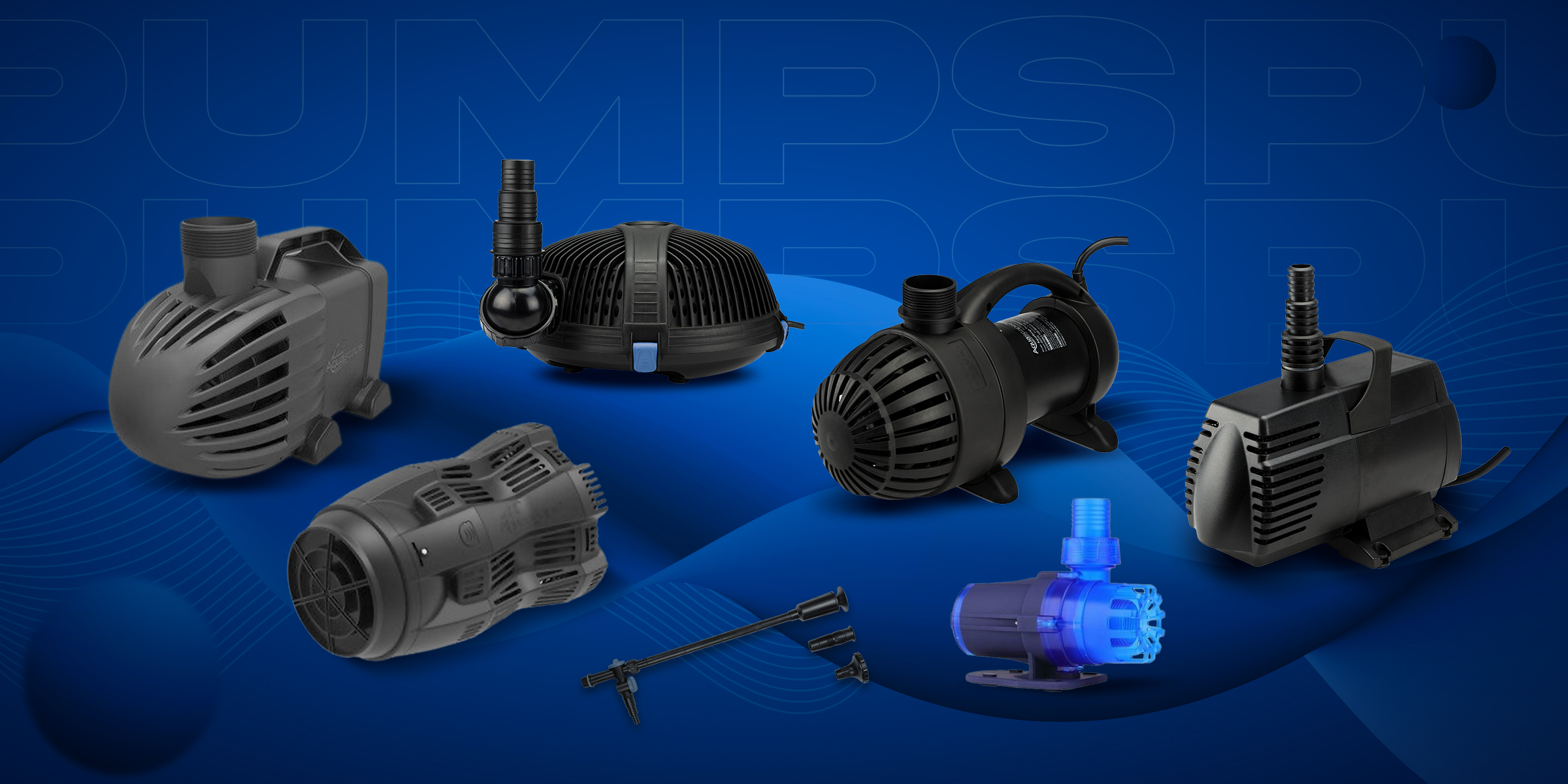Pond pumps are essential components of a healthy and thriving pond ecosystem, providing circulation, aeration, and maintaining water quality. Whether you have a small backyard pond or a larger water feature, choosing the right pond pump is crucial for the overall health of your aquatic environment.
Types of Pond Pumps
Pond pumps play a vital role in maintaining the health and functionality of a pond. They contribute to oxygenation, water circulation, and filtration, ensuring a balanced ecosystem for aquatic life. When selecting a pond pump, understanding the different types available is essential to meet the specific needs of your pond. Here’s a detailed exploration of the main types of pond pumps:
Submersible Pond Pumps
Submersible pond pumps are designed to be placed directly into the water. These pumps are fully submerged, often resting on the pond’s bottom. They are popular for small to medium-sized ponds and water features.
Some advantages are:
- Ease of Installation – Submersible pumps are relatively easy to install, requiring minimal setup.
- Discreet Design – Being underwater, they are hidden from view, providing a more aesthetically pleasing pond.
- Versatility – Suitable for various pond sizes, particularly those with limited space.
Submersible pond pumps are ideal for decorative ponds, water gardens, and smaller water features where a discreet and compact pump is preferred.
External Pond Pumps
External pond pumps, as the name suggests, are installed outside the pond. These pumps are placed at ground level or slightly elevated, drawing water from the pond and pushing it through plumbing to water features or filtration systems.
Some advantages are:
- Powerful Performance – External pumps are known for their high flow rates, making them suitable for larger ponds or koi ponds.
- Accessibility – External placement makes these pumps easy to access for maintenance and repairs.
- Reduced Heat Transfer – Being outside the water helps prevent heat transfer, keeping the water cooler.
External pond pumps are ideal for larger ponds or water features where higher flow rates are required, and easy access for maintenance is a priority.
Fountain Pumps
Fountain pumps are specialized pond pumps designed to create decorative water features, such as fountains or spitters. These pumps are often compact and come with adjustable flow rates and nozzle options for varying water displays.
Some advantages are:
- Decorative Features – Fountain pumps are specifically crafted to enhance the visual appeal of ponds with decorative water displays.
- Adjustable Flow – These pumps offer flexibility, allowing you to customize the height and pattern of the water spray.
- Easy Installation – Fountain pumps are generally easy to install and are suitable for smaller ponds or as additional features in larger ponds.
Fountain pumps are perfect for those looking to add an aesthetic element to their pond, creating visually striking water displays.
Magnetic Drive Pond Pumps
Magnetic drive pond pumps use magnetic fields to generate movement, eliminating the need for direct contact between the motor and the impeller. This design reduces wear and tear, resulting in a more durable and energy-efficient pump.
Some advantages are:
- Energy Efficiency – Magnetic drive pumps are known for their energy efficiency, making them cost-effective in the long run.
- Low Maintenance – The absence of direct contact parts reduces the need for frequent maintenance.
- Durability – The magnetic drive design enhances the pump’s overall durability and lifespan.
Magnetic drive pond pumps are suitable for various pond sizes and are a great choice for those seeking an energy-efficient and low-maintenance option.
Direct Drive Pond Pumps
Direct drive pond pumps, also known as centrifugal pumps, use a shaft to connect the motor and impeller directly. These pumps are robust and capable of handling larger volumes of water, making them suitable for sizeable ponds or waterfalls.
Some advantages are:
- High Flow Rates – Direct drive pumps offer high flow rates, making them suitable for creating waterfalls and supporting extensive filtration systems.
- Durable Construction – The direct drive design contributes to the pump’s overall durability and ability to handle heavy-duty tasks.
- Versatility – Ideal for various pond applications, including large ponds, waterfalls, and filtration systems.
The Direct drive pumps are best suited for larger ponds and water features where high flow rates and durability are essential.
Solar pond pumps
Solar pond pumps utilize solar energy to power the pump, eliminating the need for electricity. These environmentally friendly pumps are often submersible and come with solar panels for energy capture.
Some advantages are:
- Energy Efficiency – Solar pumps operate using renewable energy, reducing dependence on traditional power sources.
- Environmentally Friendly – With no electricity consumption, solar pumps have a minimal environmental impact.
- Remote Locations – Ideal for ponds in locations without access to electrical outlets.
Solar pond pumps are suitable for ponds in remote areas or for those looking to reduce their environmental footprint by using renewable energy sources.
Wanna learn about some best pond pumps, visit this page by WorldofWater.
Pond Pump Features
- The flow rate, measured in gallons per hour (GPH), indicates how much water the pump can move. Choose a pump with an appropriate flow rate for your pond size to ensure proper circulation and filtration.
- Head height refers to the vertical distance the pump can lift water. Consider the height of any water features, such as waterfalls or fountains, to select a pump that can handle the required head height.
- Energy-efficient pond pumps can save on operating costs. Look for pumps with the ENERGY STAR label or those designed to be energy-efficient, helping you maintain a healthy pond without a significant impact on your utility bills.
- Pumps with adjustable flow controls allow you to customize the water flow based on the specific needs of your pond. This feature is particularly useful for different seasons or when you want to create a more tranquil or dynamic water environment.
- Some pond pumps come with built-in UV clarifiers, which help control algae by exposing the water to ultraviolet light. This is an effective way to maintain water clarity and reduce the growth of unwanted microorganisms.
Pond Pump Placement and Sizing
Choosing the right-sized pond pump is crucial for optimal performance. Consider factors such as pond size, water volume, and the desired flow rate. Manufacturers often provide guidelines or calculators to assist in determining the appropriate pump size for your specific pond.
Place the pump in an area that maximizes water circulation. This is typically near the pond’s center or the skimmer and bottom drain. Proper placement ensures efficient water movement, contributing to improved oxygen levels and filtration.
Pond Pump Maintenance
They require regular cleaning to prevent debris buildup, which can impede performance. Check the pump intake regularly and remove any leaves, twigs, or debris that may clog the impeller or filter.
Perform seasonal maintenance, especially before winter, to prevent freezing and damage. For submersible pumps, consider removing them during winter to avoid ice-related issues. External pumps may require additional winterization steps.
Inspect the pump and tubing for any blockages that may hinder water flow. A blocked pump can strain the motor and lead to decreased efficiency.
Interested in gardening supplies and tools, learn about garden storage box.
Importance of Pond Pumps in Ecosystems
- Pond pumps play a crucial role in oxygenating the water. By circulating the water, they expose it to the air, promoting the exchange of gases and ensuring an adequate oxygen supply for fish and beneficial bacteria.
- Pond pumps work in tandem with filters to remove debris and particulate matter from the water. This contributes to water clarity and prevents the accumulation of organic materials that could compromise water quality.
- Stagnant water can lead to a host of issues, including algae blooms and unpleasant odors. Pond pumps prevent stagnation by maintaining water movement, and discouraging the growth of undesirable microorganisms.
- In warmer months, pond pumps help regulate water temperature by preventing stratification. This ensures a more uniform distribution of temperature throughout the pond, benefiting both aquatic life and water quality.
Pond Pump Accessories
- Pond Filters – Pond filters work in conjunction with pumps to enhance water clarity. They trap debris and particles, preventing them from re-entering the pond. Consider the type and size of the filter to match your pond’s needs.
- Pond Skimmers – Skimmers remove debris from the water’s surface before it sinks to the bottom. A skimmer, when used with a pond pump, reduces the workload on the pump and helps maintain a cleaner pond.
- Waterfall and Fountain Kits – Enhance the visual appeal of your pond by adding a waterfall or fountain. Many pond pumps are compatible with waterfall and fountain kits, allowing you to create stunning water features.
FAQs
What types of pond pumps are suitable for different pond sizes?
Submersible pond pumps are suitable for smaller ponds, while external pumps are ideal for larger water features. The choice depends on factors such as pond size, flow rate requirements, and the desired level of customization.
Why is pond pump maintenance important for optimal performance?
Regular maintenance, including cleaning debris and checking for blockages, is crucial for optimal pond pump performance. It prevents motor strain, ensures efficient water flow, and extends the lifespan of the pump.
What is the best pump for a pond?
The Oase Aquamax Eco Premium, which many consider to be the best pond pump available, is most certainly the choice. You get all you need in a pond pump with the Eco Premium: dependability, economy, and reduced operating expenses. The Eco Premium additionally has a premium satellite strainer with Swell.
What size pump should I use for my pond?
It is advised to choose a pump whose flow rate is ½ the pond’s size, for example. You should choose a pump, like the UltraFlow 3000, with a 3000LPH flow rate if your pond is 6000L.
What is pond pump?
The first equipment you often install in a garden pond is a pond pump, which helps maintain the pond’s health and freshness by enabling the water to be transferred to a filter.
What are the benefits of a pond pump?
In addition to filtering and introducing oxygen to the water, it will move the water about the pond. Water tends to circulate when pumps are used alone. Pumps that supply fountains or other water features can assist in oxygenating the water, and pumps that have filters can help clean the water.
Conclusion
Pond pumps are integral to maintaining a balanced and thriving pond ecosystem. Whether you have a small decorative pond or a large koi pond, selecting the right pump involves considering factors such as pump type, features, sizing, and maintenance requirements.
The strategic placement of the pump, coupled with accessories like filters and skimmers, ensures optimal water circulation, oxygenation, and filtration. By understanding the role of pond pumps and choosing wisely, you can create a beautiful and healthy aquatic environment that enhances the overall appeal of your outdoor space.



2 replies on “Pond Pumps – A Deep Dive into Types, Maintenance, and Benefits”
[…] Interested in gardening, learn about pond pumps. […]
[…] In this exploration, we delve into the world of sprinkler systems, examining their types, components, installation, and the significant role they play in sustainable water management. […]